Mental Health: Impacts of Seclusion and Restraint on Consumers
VerifiedAdded on 2022/09/07
|12
|3467
|22
Essay
AI Summary
This essay critically examines the impacts of seclusion and restraint in healthcare settings, highlighting the negative psychological, physical, and emotional effects on both consumers and healthcare professionals. It explores the role of registered nurses in mitigating these impacts by collaborating on strategies to reduce the use of seclusion and restraint. The essay discusses initiatives like Safewards, continuity of care, therapeutic rapport, and quality improvement interventions. It emphasizes the importance of alternative measures, proper patient assessment, and a supportive care environment. The goal is to foster a safer and more patient-centered approach to mental healthcare, focusing on reducing the reliance on restrictive practices. The essay provides a comprehensive overview of the current challenges and potential solutions for improving mental health care practices, emphasizing the need for a shift towards less restrictive approaches and a focus on patient well-being.
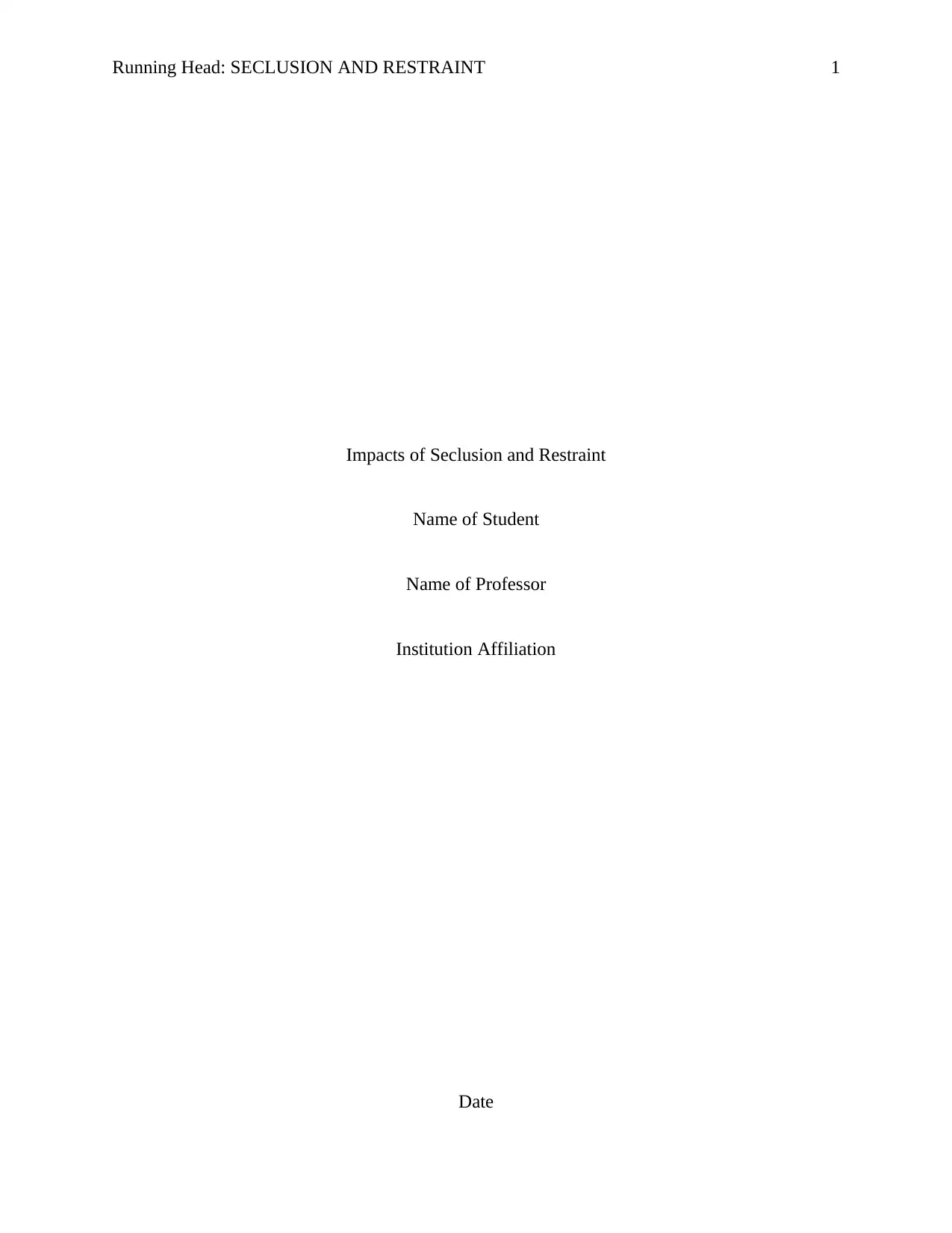
Running Head: SECLUSION AND RESTRAINT 1
Impacts of Seclusion and Restraint
Name of Student
Name of Professor
Institution Affiliation
Date
Impacts of Seclusion and Restraint
Name of Student
Name of Professor
Institution Affiliation
Date
Paraphrase This Document
Need a fresh take? Get an instant paraphrase of this document with our AI Paraphraser
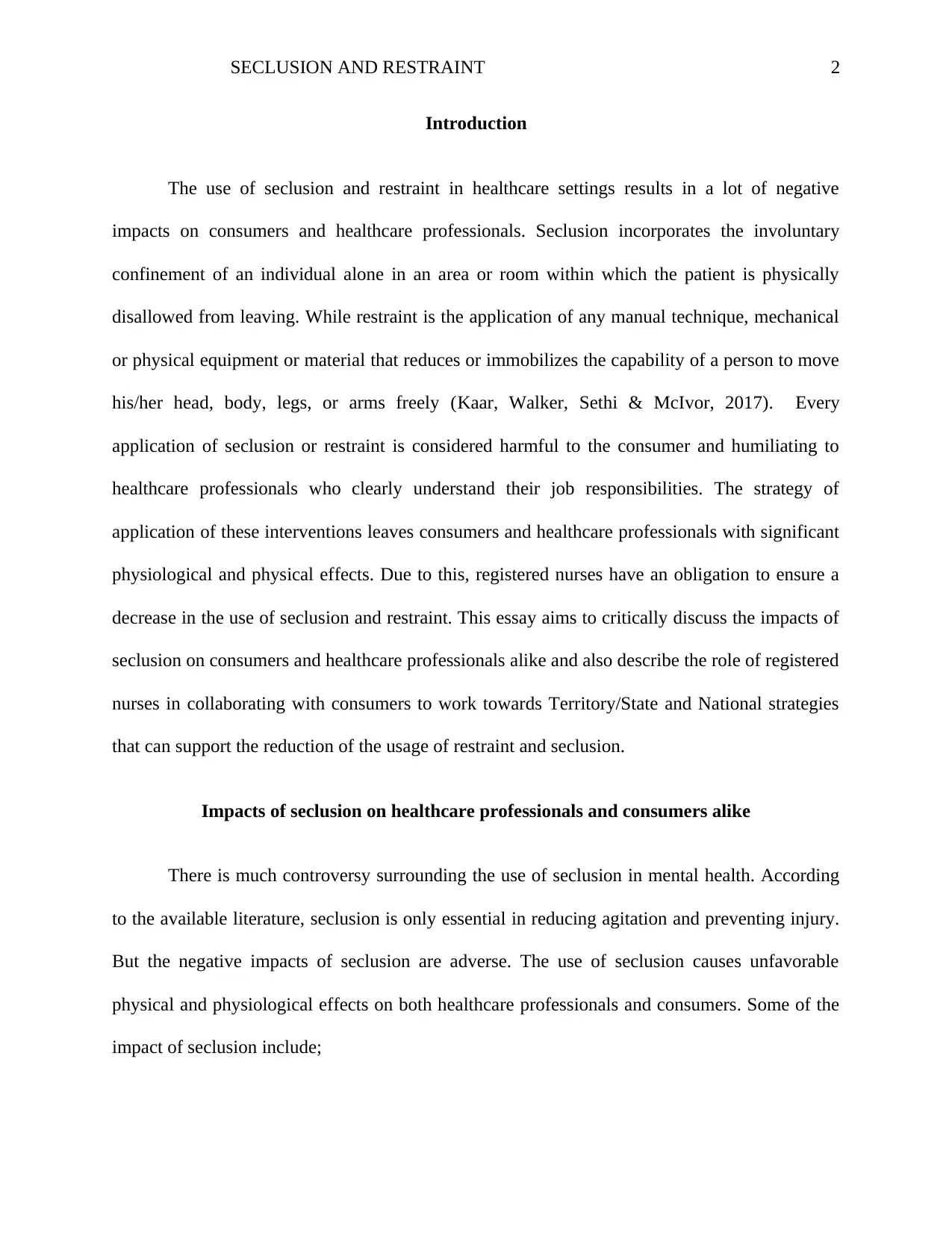
SECLUSION AND RESTRAINT 2
Introduction
The use of seclusion and restraint in healthcare settings results in a lot of negative
impacts on consumers and healthcare professionals. Seclusion incorporates the involuntary
confinement of an individual alone in an area or room within which the patient is physically
disallowed from leaving. While restraint is the application of any manual technique, mechanical
or physical equipment or material that reduces or immobilizes the capability of a person to move
his/her head, body, legs, or arms freely (Kaar, Walker, Sethi & McIvor, 2017). Every
application of seclusion or restraint is considered harmful to the consumer and humiliating to
healthcare professionals who clearly understand their job responsibilities. The strategy of
application of these interventions leaves consumers and healthcare professionals with significant
physiological and physical effects. Due to this, registered nurses have an obligation to ensure a
decrease in the use of seclusion and restraint. This essay aims to critically discuss the impacts of
seclusion on consumers and healthcare professionals alike and also describe the role of registered
nurses in collaborating with consumers to work towards Territory/State and National strategies
that can support the reduction of the usage of restraint and seclusion.
Impacts of seclusion on healthcare professionals and consumers alike
There is much controversy surrounding the use of seclusion in mental health. According
to the available literature, seclusion is only essential in reducing agitation and preventing injury.
But the negative impacts of seclusion are adverse. The use of seclusion causes unfavorable
physical and physiological effects on both healthcare professionals and consumers. Some of the
impact of seclusion include;
Introduction
The use of seclusion and restraint in healthcare settings results in a lot of negative
impacts on consumers and healthcare professionals. Seclusion incorporates the involuntary
confinement of an individual alone in an area or room within which the patient is physically
disallowed from leaving. While restraint is the application of any manual technique, mechanical
or physical equipment or material that reduces or immobilizes the capability of a person to move
his/her head, body, legs, or arms freely (Kaar, Walker, Sethi & McIvor, 2017). Every
application of seclusion or restraint is considered harmful to the consumer and humiliating to
healthcare professionals who clearly understand their job responsibilities. The strategy of
application of these interventions leaves consumers and healthcare professionals with significant
physiological and physical effects. Due to this, registered nurses have an obligation to ensure a
decrease in the use of seclusion and restraint. This essay aims to critically discuss the impacts of
seclusion on consumers and healthcare professionals alike and also describe the role of registered
nurses in collaborating with consumers to work towards Territory/State and National strategies
that can support the reduction of the usage of restraint and seclusion.
Impacts of seclusion on healthcare professionals and consumers alike
There is much controversy surrounding the use of seclusion in mental health. According
to the available literature, seclusion is only essential in reducing agitation and preventing injury.
But the negative impacts of seclusion are adverse. The use of seclusion causes unfavorable
physical and physiological effects on both healthcare professionals and consumers. Some of the
impact of seclusion include;
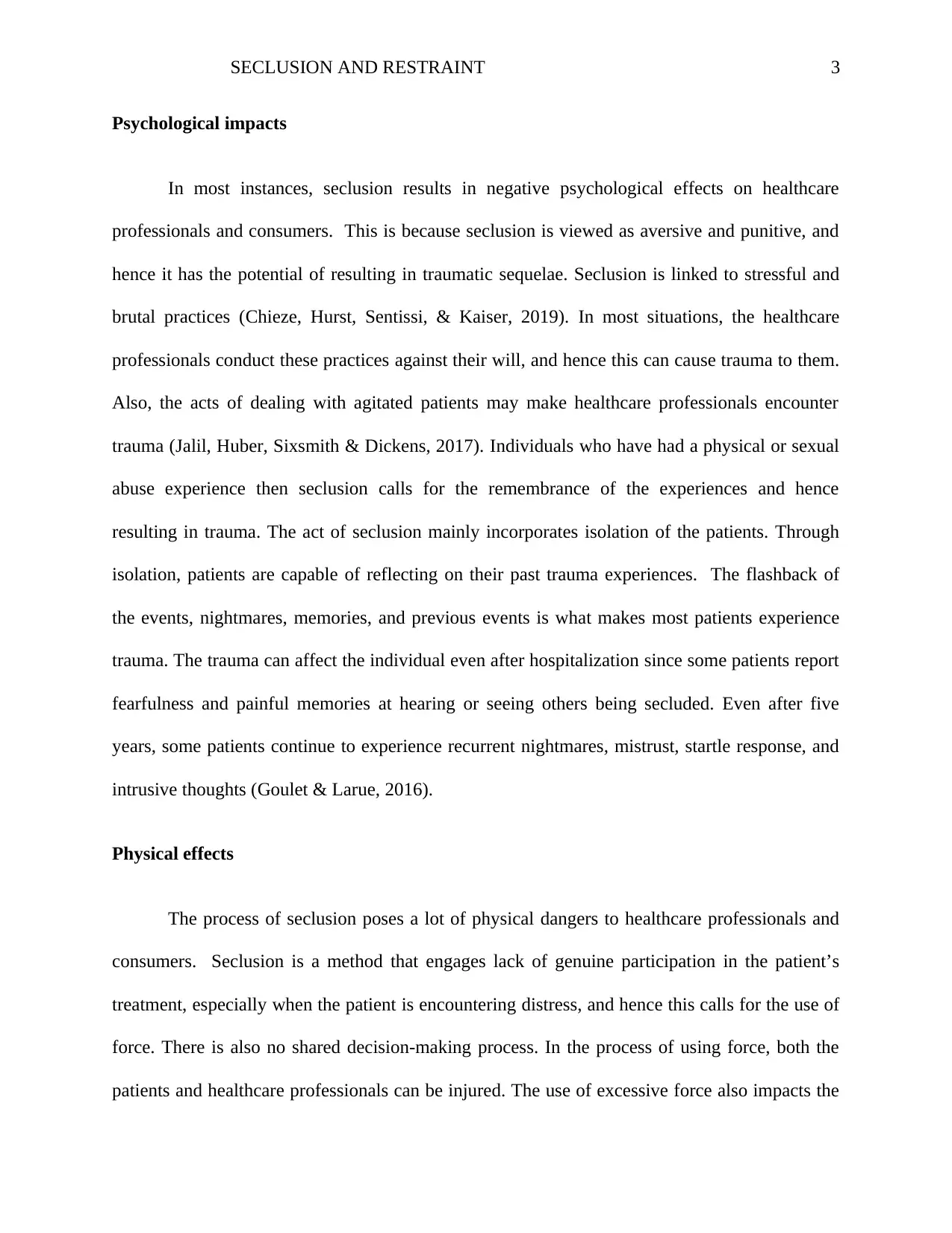
SECLUSION AND RESTRAINT 3
Psychological impacts
In most instances, seclusion results in negative psychological effects on healthcare
professionals and consumers. This is because seclusion is viewed as aversive and punitive, and
hence it has the potential of resulting in traumatic sequelae. Seclusion is linked to stressful and
brutal practices (Chieze, Hurst, Sentissi, & Kaiser, 2019). In most situations, the healthcare
professionals conduct these practices against their will, and hence this can cause trauma to them.
Also, the acts of dealing with agitated patients may make healthcare professionals encounter
trauma (Jalil, Huber, Sixsmith & Dickens, 2017). Individuals who have had a physical or sexual
abuse experience then seclusion calls for the remembrance of the experiences and hence
resulting in trauma. The act of seclusion mainly incorporates isolation of the patients. Through
isolation, patients are capable of reflecting on their past trauma experiences. The flashback of
the events, nightmares, memories, and previous events is what makes most patients experience
trauma. The trauma can affect the individual even after hospitalization since some patients report
fearfulness and painful memories at hearing or seeing others being secluded. Even after five
years, some patients continue to experience recurrent nightmares, mistrust, startle response, and
intrusive thoughts (Goulet & Larue, 2016).
Physical effects
The process of seclusion poses a lot of physical dangers to healthcare professionals and
consumers. Seclusion is a method that engages lack of genuine participation in the patient’s
treatment, especially when the patient is encountering distress, and hence this calls for the use of
force. There is also no shared decision-making process. In the process of using force, both the
patients and healthcare professionals can be injured. The use of excessive force also impacts the
Psychological impacts
In most instances, seclusion results in negative psychological effects on healthcare
professionals and consumers. This is because seclusion is viewed as aversive and punitive, and
hence it has the potential of resulting in traumatic sequelae. Seclusion is linked to stressful and
brutal practices (Chieze, Hurst, Sentissi, & Kaiser, 2019). In most situations, the healthcare
professionals conduct these practices against their will, and hence this can cause trauma to them.
Also, the acts of dealing with agitated patients may make healthcare professionals encounter
trauma (Jalil, Huber, Sixsmith & Dickens, 2017). Individuals who have had a physical or sexual
abuse experience then seclusion calls for the remembrance of the experiences and hence
resulting in trauma. The act of seclusion mainly incorporates isolation of the patients. Through
isolation, patients are capable of reflecting on their past trauma experiences. The flashback of
the events, nightmares, memories, and previous events is what makes most patients experience
trauma. The trauma can affect the individual even after hospitalization since some patients report
fearfulness and painful memories at hearing or seeing others being secluded. Even after five
years, some patients continue to experience recurrent nightmares, mistrust, startle response, and
intrusive thoughts (Goulet & Larue, 2016).
Physical effects
The process of seclusion poses a lot of physical dangers to healthcare professionals and
consumers. Seclusion is a method that engages lack of genuine participation in the patient’s
treatment, especially when the patient is encountering distress, and hence this calls for the use of
force. There is also no shared decision-making process. In the process of using force, both the
patients and healthcare professionals can be injured. The use of excessive force also impacts the
⊘ This is a preview!⊘
Do you want full access?
Subscribe today to unlock all pages.

Trusted by 1+ million students worldwide
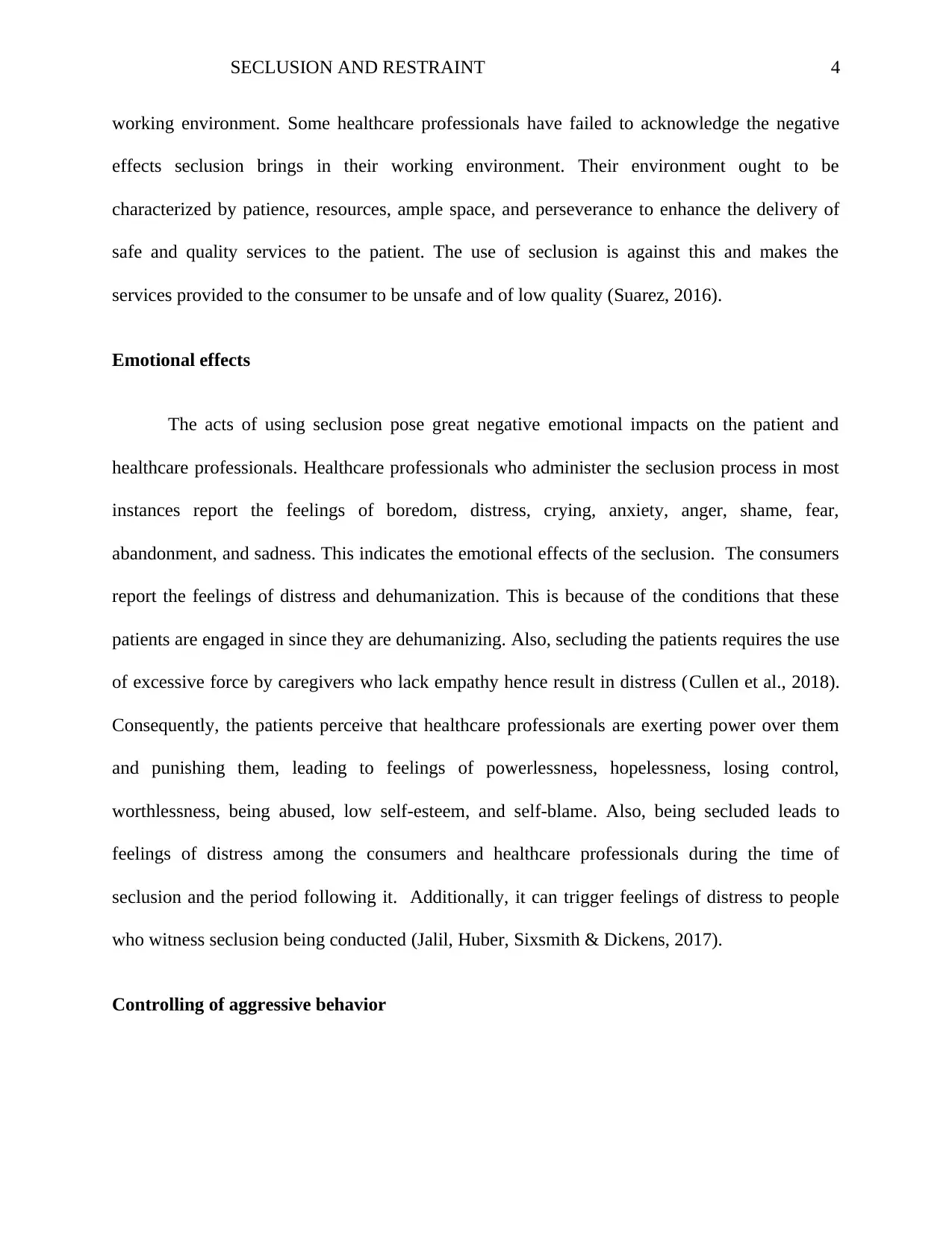
SECLUSION AND RESTRAINT 4
working environment. Some healthcare professionals have failed to acknowledge the negative
effects seclusion brings in their working environment. Their environment ought to be
characterized by patience, resources, ample space, and perseverance to enhance the delivery of
safe and quality services to the patient. The use of seclusion is against this and makes the
services provided to the consumer to be unsafe and of low quality (Suarez, 2016).
Emotional effects
The acts of using seclusion pose great negative emotional impacts on the patient and
healthcare professionals. Healthcare professionals who administer the seclusion process in most
instances report the feelings of boredom, distress, crying, anxiety, anger, shame, fear,
abandonment, and sadness. This indicates the emotional effects of the seclusion. The consumers
report the feelings of distress and dehumanization. This is because of the conditions that these
patients are engaged in since they are dehumanizing. Also, secluding the patients requires the use
of excessive force by caregivers who lack empathy hence result in distress (Cullen et al., 2018).
Consequently, the patients perceive that healthcare professionals are exerting power over them
and punishing them, leading to feelings of powerlessness, hopelessness, losing control,
worthlessness, being abused, low self-esteem, and self-blame. Also, being secluded leads to
feelings of distress among the consumers and healthcare professionals during the time of
seclusion and the period following it. Additionally, it can trigger feelings of distress to people
who witness seclusion being conducted (Jalil, Huber, Sixsmith & Dickens, 2017).
Controlling of aggressive behavior
working environment. Some healthcare professionals have failed to acknowledge the negative
effects seclusion brings in their working environment. Their environment ought to be
characterized by patience, resources, ample space, and perseverance to enhance the delivery of
safe and quality services to the patient. The use of seclusion is against this and makes the
services provided to the consumer to be unsafe and of low quality (Suarez, 2016).
Emotional effects
The acts of using seclusion pose great negative emotional impacts on the patient and
healthcare professionals. Healthcare professionals who administer the seclusion process in most
instances report the feelings of boredom, distress, crying, anxiety, anger, shame, fear,
abandonment, and sadness. This indicates the emotional effects of the seclusion. The consumers
report the feelings of distress and dehumanization. This is because of the conditions that these
patients are engaged in since they are dehumanizing. Also, secluding the patients requires the use
of excessive force by caregivers who lack empathy hence result in distress (Cullen et al., 2018).
Consequently, the patients perceive that healthcare professionals are exerting power over them
and punishing them, leading to feelings of powerlessness, hopelessness, losing control,
worthlessness, being abused, low self-esteem, and self-blame. Also, being secluded leads to
feelings of distress among the consumers and healthcare professionals during the time of
seclusion and the period following it. Additionally, it can trigger feelings of distress to people
who witness seclusion being conducted (Jalil, Huber, Sixsmith & Dickens, 2017).
Controlling of aggressive behavior
Paraphrase This Document
Need a fresh take? Get an instant paraphrase of this document with our AI Paraphraser
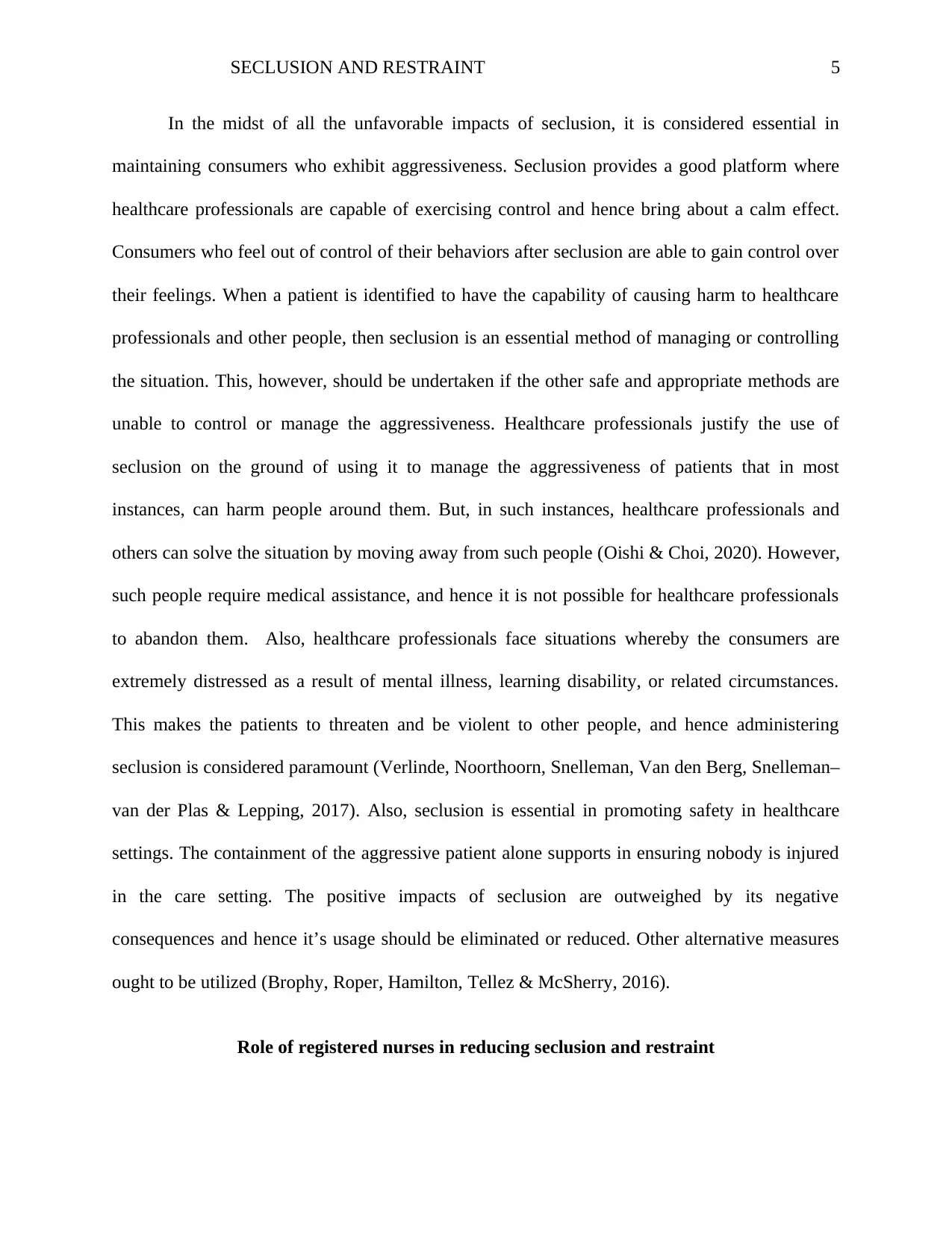
SECLUSION AND RESTRAINT 5
In the midst of all the unfavorable impacts of seclusion, it is considered essential in
maintaining consumers who exhibit aggressiveness. Seclusion provides a good platform where
healthcare professionals are capable of exercising control and hence bring about a calm effect.
Consumers who feel out of control of their behaviors after seclusion are able to gain control over
their feelings. When a patient is identified to have the capability of causing harm to healthcare
professionals and other people, then seclusion is an essential method of managing or controlling
the situation. This, however, should be undertaken if the other safe and appropriate methods are
unable to control or manage the aggressiveness. Healthcare professionals justify the use of
seclusion on the ground of using it to manage the aggressiveness of patients that in most
instances, can harm people around them. But, in such instances, healthcare professionals and
others can solve the situation by moving away from such people (Oishi & Choi, 2020). However,
such people require medical assistance, and hence it is not possible for healthcare professionals
to abandon them. Also, healthcare professionals face situations whereby the consumers are
extremely distressed as a result of mental illness, learning disability, or related circumstances.
This makes the patients to threaten and be violent to other people, and hence administering
seclusion is considered paramount (Verlinde, Noorthoorn, Snelleman, Van den Berg, Snelleman–
van der Plas & Lepping, 2017). Also, seclusion is essential in promoting safety in healthcare
settings. The containment of the aggressive patient alone supports in ensuring nobody is injured
in the care setting. The positive impacts of seclusion are outweighed by its negative
consequences and hence it’s usage should be eliminated or reduced. Other alternative measures
ought to be utilized (Brophy, Roper, Hamilton, Tellez & McSherry, 2016).
Role of registered nurses in reducing seclusion and restraint
In the midst of all the unfavorable impacts of seclusion, it is considered essential in
maintaining consumers who exhibit aggressiveness. Seclusion provides a good platform where
healthcare professionals are capable of exercising control and hence bring about a calm effect.
Consumers who feel out of control of their behaviors after seclusion are able to gain control over
their feelings. When a patient is identified to have the capability of causing harm to healthcare
professionals and other people, then seclusion is an essential method of managing or controlling
the situation. This, however, should be undertaken if the other safe and appropriate methods are
unable to control or manage the aggressiveness. Healthcare professionals justify the use of
seclusion on the ground of using it to manage the aggressiveness of patients that in most
instances, can harm people around them. But, in such instances, healthcare professionals and
others can solve the situation by moving away from such people (Oishi & Choi, 2020). However,
such people require medical assistance, and hence it is not possible for healthcare professionals
to abandon them. Also, healthcare professionals face situations whereby the consumers are
extremely distressed as a result of mental illness, learning disability, or related circumstances.
This makes the patients to threaten and be violent to other people, and hence administering
seclusion is considered paramount (Verlinde, Noorthoorn, Snelleman, Van den Berg, Snelleman–
van der Plas & Lepping, 2017). Also, seclusion is essential in promoting safety in healthcare
settings. The containment of the aggressive patient alone supports in ensuring nobody is injured
in the care setting. The positive impacts of seclusion are outweighed by its negative
consequences and hence it’s usage should be eliminated or reduced. Other alternative measures
ought to be utilized (Brophy, Roper, Hamilton, Tellez & McSherry, 2016).
Role of registered nurses in reducing seclusion and restraint
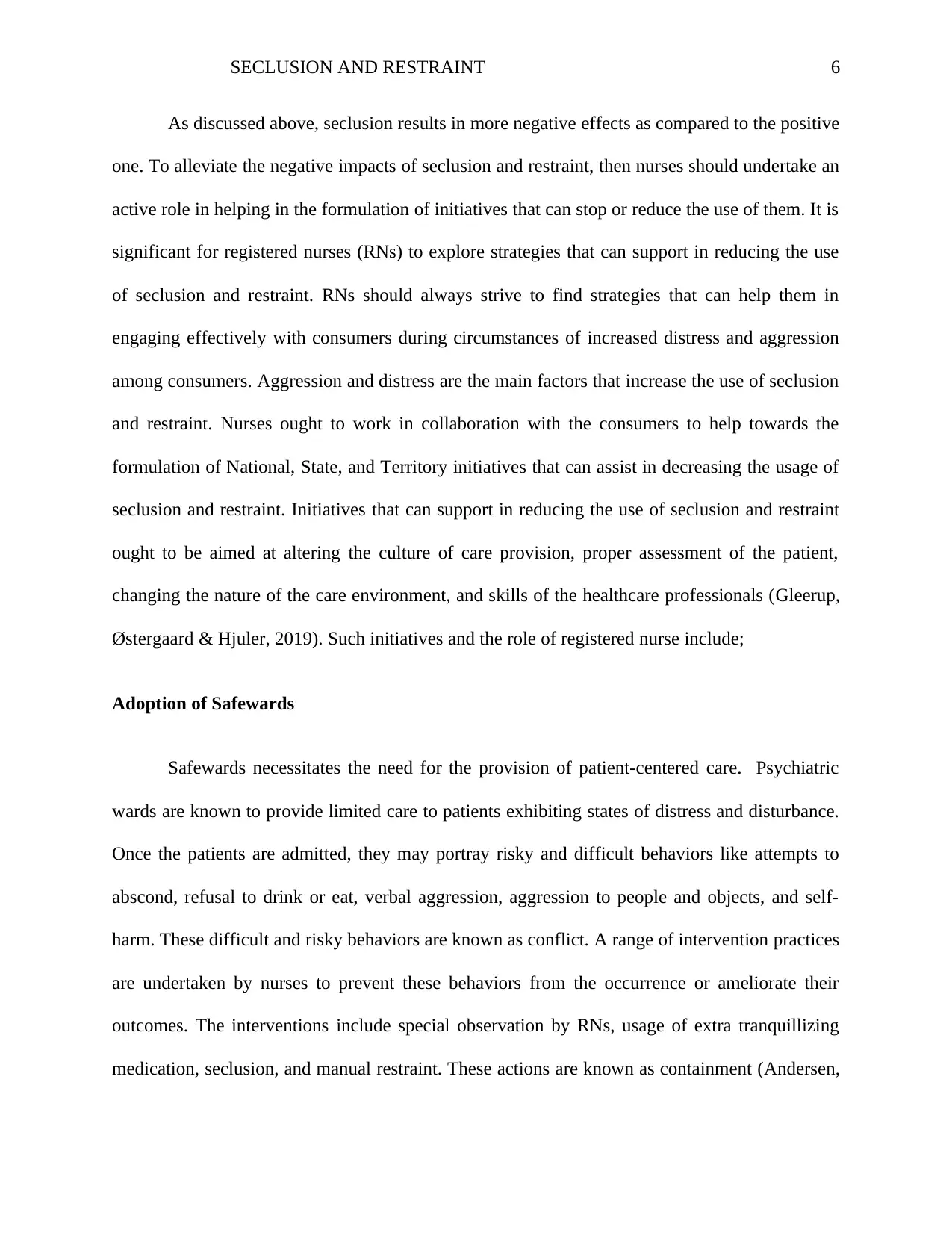
SECLUSION AND RESTRAINT 6
As discussed above, seclusion results in more negative effects as compared to the positive
one. To alleviate the negative impacts of seclusion and restraint, then nurses should undertake an
active role in helping in the formulation of initiatives that can stop or reduce the use of them. It is
significant for registered nurses (RNs) to explore strategies that can support in reducing the use
of seclusion and restraint. RNs should always strive to find strategies that can help them in
engaging effectively with consumers during circumstances of increased distress and aggression
among consumers. Aggression and distress are the main factors that increase the use of seclusion
and restraint. Nurses ought to work in collaboration with the consumers to help towards the
formulation of National, State, and Territory initiatives that can assist in decreasing the usage of
seclusion and restraint. Initiatives that can support in reducing the use of seclusion and restraint
ought to be aimed at altering the culture of care provision, proper assessment of the patient,
changing the nature of the care environment, and skills of the healthcare professionals (Gleerup,
Østergaard & Hjuler, 2019). Such initiatives and the role of registered nurse include;
Adoption of Safewards
Safewards necessitates the need for the provision of patient-centered care. Psychiatric
wards are known to provide limited care to patients exhibiting states of distress and disturbance.
Once the patients are admitted, they may portray risky and difficult behaviors like attempts to
abscond, refusal to drink or eat, verbal aggression, aggression to people and objects, and self-
harm. These difficult and risky behaviors are known as conflict. A range of intervention practices
are undertaken by nurses to prevent these behaviors from the occurrence or ameliorate their
outcomes. The interventions include special observation by RNs, usage of extra tranquillizing
medication, seclusion, and manual restraint. These actions are known as containment (Andersen,
As discussed above, seclusion results in more negative effects as compared to the positive
one. To alleviate the negative impacts of seclusion and restraint, then nurses should undertake an
active role in helping in the formulation of initiatives that can stop or reduce the use of them. It is
significant for registered nurses (RNs) to explore strategies that can support in reducing the use
of seclusion and restraint. RNs should always strive to find strategies that can help them in
engaging effectively with consumers during circumstances of increased distress and aggression
among consumers. Aggression and distress are the main factors that increase the use of seclusion
and restraint. Nurses ought to work in collaboration with the consumers to help towards the
formulation of National, State, and Territory initiatives that can assist in decreasing the usage of
seclusion and restraint. Initiatives that can support in reducing the use of seclusion and restraint
ought to be aimed at altering the culture of care provision, proper assessment of the patient,
changing the nature of the care environment, and skills of the healthcare professionals (Gleerup,
Østergaard & Hjuler, 2019). Such initiatives and the role of registered nurse include;
Adoption of Safewards
Safewards necessitates the need for the provision of patient-centered care. Psychiatric
wards are known to provide limited care to patients exhibiting states of distress and disturbance.
Once the patients are admitted, they may portray risky and difficult behaviors like attempts to
abscond, refusal to drink or eat, verbal aggression, aggression to people and objects, and self-
harm. These difficult and risky behaviors are known as conflict. A range of intervention practices
are undertaken by nurses to prevent these behaviors from the occurrence or ameliorate their
outcomes. The interventions include special observation by RNs, usage of extra tranquillizing
medication, seclusion, and manual restraint. These actions are known as containment (Andersen,
⊘ This is a preview!⊘
Do you want full access?
Subscribe today to unlock all pages.

Trusted by 1+ million students worldwide
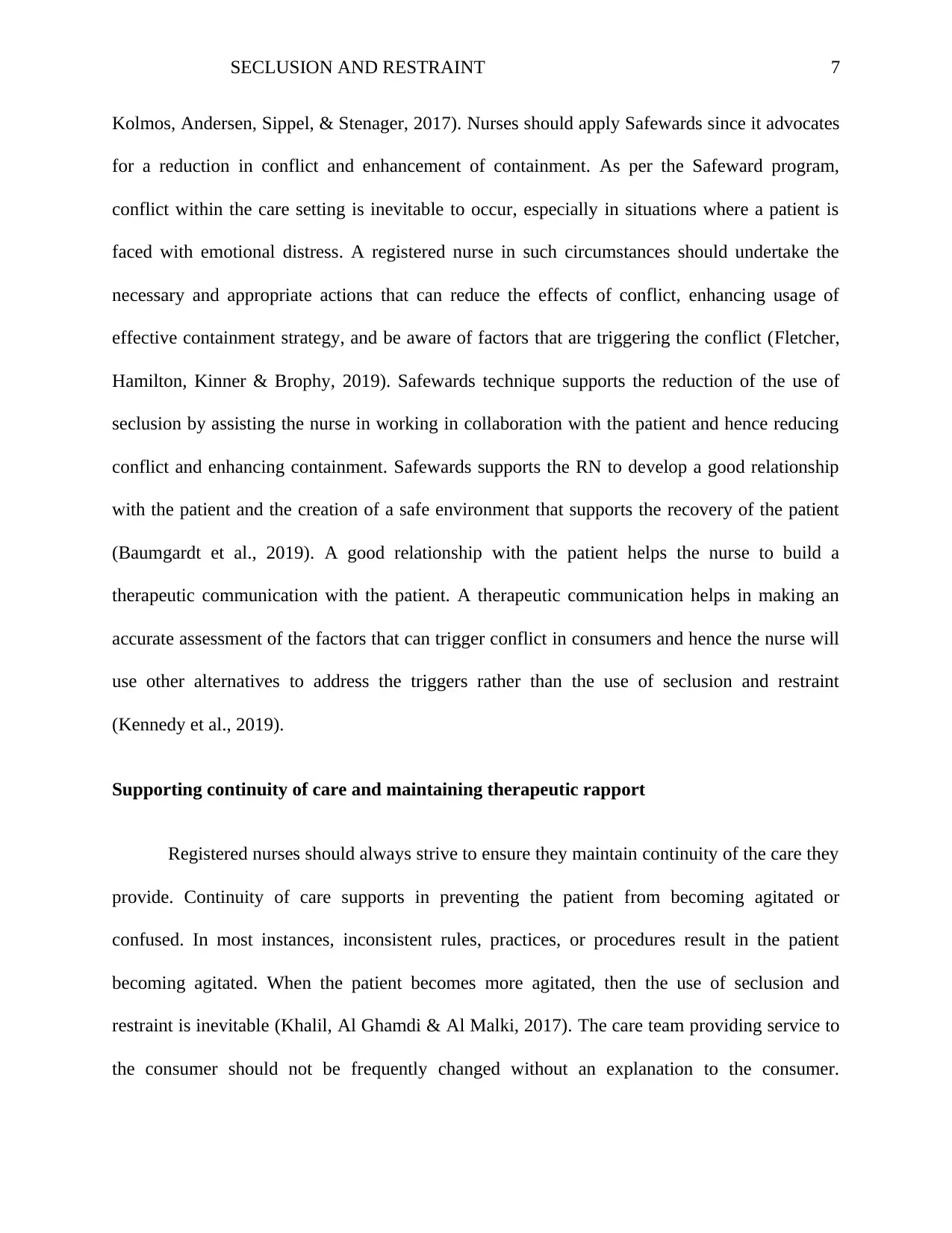
SECLUSION AND RESTRAINT 7
Kolmos, Andersen, Sippel, & Stenager, 2017). Nurses should apply Safewards since it advocates
for a reduction in conflict and enhancement of containment. As per the Safeward program,
conflict within the care setting is inevitable to occur, especially in situations where a patient is
faced with emotional distress. A registered nurse in such circumstances should undertake the
necessary and appropriate actions that can reduce the effects of conflict, enhancing usage of
effective containment strategy, and be aware of factors that are triggering the conflict (Fletcher,
Hamilton, Kinner & Brophy, 2019). Safewards technique supports the reduction of the use of
seclusion by assisting the nurse in working in collaboration with the patient and hence reducing
conflict and enhancing containment. Safewards supports the RN to develop a good relationship
with the patient and the creation of a safe environment that supports the recovery of the patient
(Baumgardt et al., 2019). A good relationship with the patient helps the nurse to build a
therapeutic communication with the patient. A therapeutic communication helps in making an
accurate assessment of the factors that can trigger conflict in consumers and hence the nurse will
use other alternatives to address the triggers rather than the use of seclusion and restraint
(Kennedy et al., 2019).
Supporting continuity of care and maintaining therapeutic rapport
Registered nurses should always strive to ensure they maintain continuity of the care they
provide. Continuity of care supports in preventing the patient from becoming agitated or
confused. In most instances, inconsistent rules, practices, or procedures result in the patient
becoming agitated. When the patient becomes more agitated, then the use of seclusion and
restraint is inevitable (Khalil, Al Ghamdi & Al Malki, 2017). The care team providing service to
the consumer should not be frequently changed without an explanation to the consumer.
Kolmos, Andersen, Sippel, & Stenager, 2017). Nurses should apply Safewards since it advocates
for a reduction in conflict and enhancement of containment. As per the Safeward program,
conflict within the care setting is inevitable to occur, especially in situations where a patient is
faced with emotional distress. A registered nurse in such circumstances should undertake the
necessary and appropriate actions that can reduce the effects of conflict, enhancing usage of
effective containment strategy, and be aware of factors that are triggering the conflict (Fletcher,
Hamilton, Kinner & Brophy, 2019). Safewards technique supports the reduction of the use of
seclusion by assisting the nurse in working in collaboration with the patient and hence reducing
conflict and enhancing containment. Safewards supports the RN to develop a good relationship
with the patient and the creation of a safe environment that supports the recovery of the patient
(Baumgardt et al., 2019). A good relationship with the patient helps the nurse to build a
therapeutic communication with the patient. A therapeutic communication helps in making an
accurate assessment of the factors that can trigger conflict in consumers and hence the nurse will
use other alternatives to address the triggers rather than the use of seclusion and restraint
(Kennedy et al., 2019).
Supporting continuity of care and maintaining therapeutic rapport
Registered nurses should always strive to ensure they maintain continuity of the care they
provide. Continuity of care supports in preventing the patient from becoming agitated or
confused. In most instances, inconsistent rules, practices, or procedures result in the patient
becoming agitated. When the patient becomes more agitated, then the use of seclusion and
restraint is inevitable (Khalil, Al Ghamdi & Al Malki, 2017). The care team providing service to
the consumer should not be frequently changed without an explanation to the consumer.
Paraphrase This Document
Need a fresh take? Get an instant paraphrase of this document with our AI Paraphraser
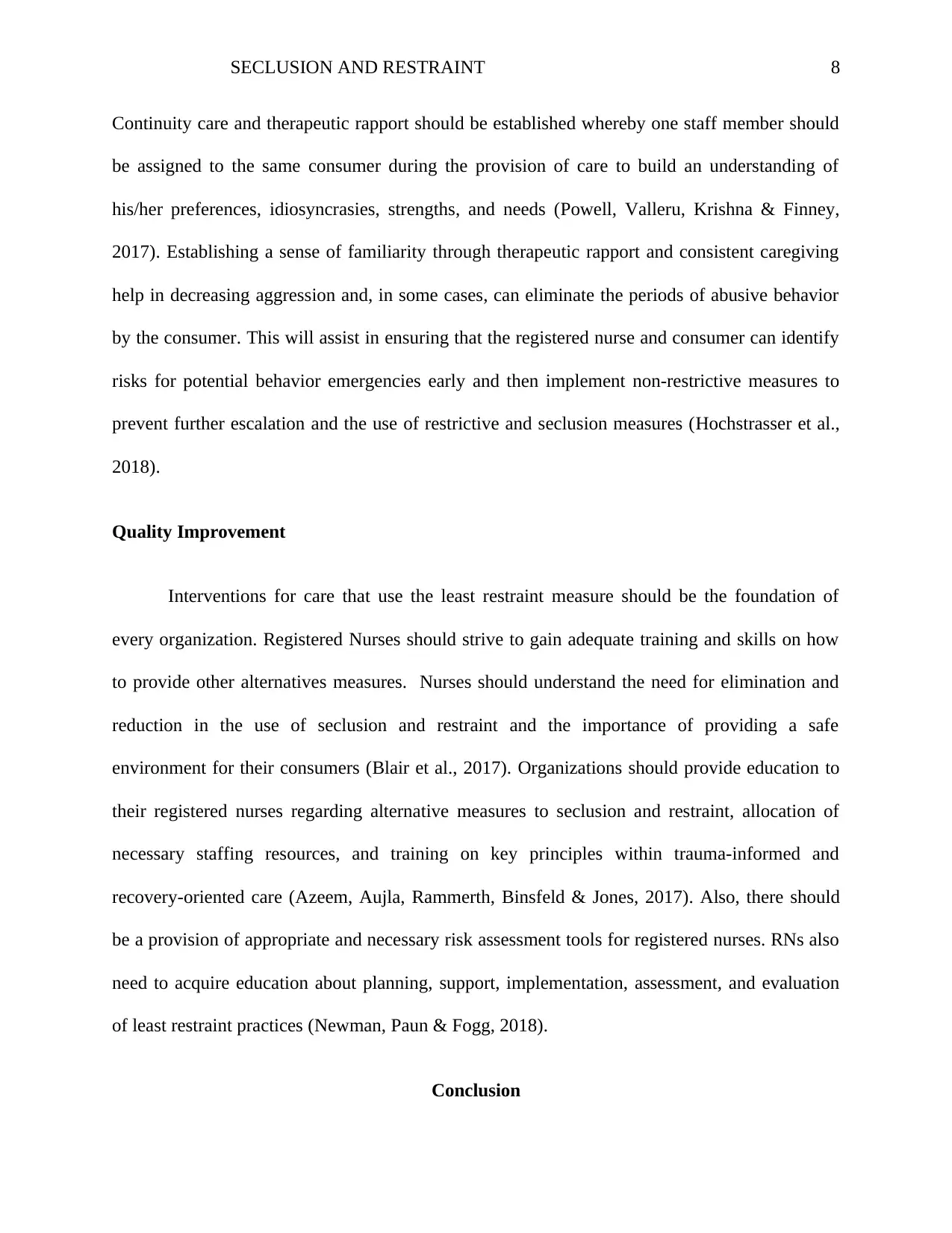
SECLUSION AND RESTRAINT 8
Continuity care and therapeutic rapport should be established whereby one staff member should
be assigned to the same consumer during the provision of care to build an understanding of
his/her preferences, idiosyncrasies, strengths, and needs (Powell, Valleru, Krishna & Finney,
2017). Establishing a sense of familiarity through therapeutic rapport and consistent caregiving
help in decreasing aggression and, in some cases, can eliminate the periods of abusive behavior
by the consumer. This will assist in ensuring that the registered nurse and consumer can identify
risks for potential behavior emergencies early and then implement non-restrictive measures to
prevent further escalation and the use of restrictive and seclusion measures (Hochstrasser et al.,
2018).
Quality Improvement
Interventions for care that use the least restraint measure should be the foundation of
every organization. Registered Nurses should strive to gain adequate training and skills on how
to provide other alternatives measures. Nurses should understand the need for elimination and
reduction in the use of seclusion and restraint and the importance of providing a safe
environment for their consumers (Blair et al., 2017). Organizations should provide education to
their registered nurses regarding alternative measures to seclusion and restraint, allocation of
necessary staffing resources, and training on key principles within trauma-informed and
recovery-oriented care (Azeem, Aujla, Rammerth, Binsfeld & Jones, 2017). Also, there should
be a provision of appropriate and necessary risk assessment tools for registered nurses. RNs also
need to acquire education about planning, support, implementation, assessment, and evaluation
of least restraint practices (Newman, Paun & Fogg, 2018).
Conclusion
Continuity care and therapeutic rapport should be established whereby one staff member should
be assigned to the same consumer during the provision of care to build an understanding of
his/her preferences, idiosyncrasies, strengths, and needs (Powell, Valleru, Krishna & Finney,
2017). Establishing a sense of familiarity through therapeutic rapport and consistent caregiving
help in decreasing aggression and, in some cases, can eliminate the periods of abusive behavior
by the consumer. This will assist in ensuring that the registered nurse and consumer can identify
risks for potential behavior emergencies early and then implement non-restrictive measures to
prevent further escalation and the use of restrictive and seclusion measures (Hochstrasser et al.,
2018).
Quality Improvement
Interventions for care that use the least restraint measure should be the foundation of
every organization. Registered Nurses should strive to gain adequate training and skills on how
to provide other alternatives measures. Nurses should understand the need for elimination and
reduction in the use of seclusion and restraint and the importance of providing a safe
environment for their consumers (Blair et al., 2017). Organizations should provide education to
their registered nurses regarding alternative measures to seclusion and restraint, allocation of
necessary staffing resources, and training on key principles within trauma-informed and
recovery-oriented care (Azeem, Aujla, Rammerth, Binsfeld & Jones, 2017). Also, there should
be a provision of appropriate and necessary risk assessment tools for registered nurses. RNs also
need to acquire education about planning, support, implementation, assessment, and evaluation
of least restraint practices (Newman, Paun & Fogg, 2018).
Conclusion
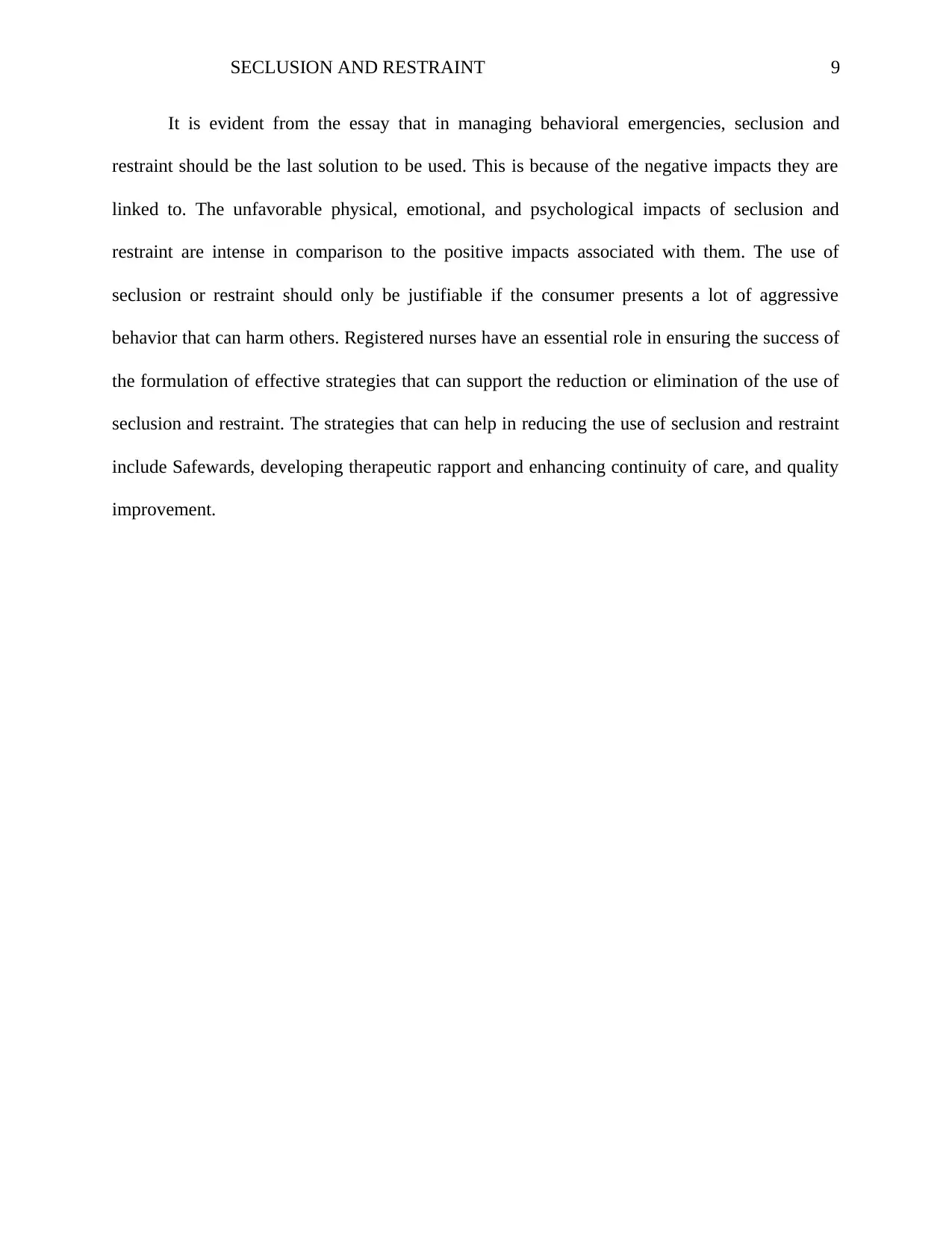
SECLUSION AND RESTRAINT 9
It is evident from the essay that in managing behavioral emergencies, seclusion and
restraint should be the last solution to be used. This is because of the negative impacts they are
linked to. The unfavorable physical, emotional, and psychological impacts of seclusion and
restraint are intense in comparison to the positive impacts associated with them. The use of
seclusion or restraint should only be justifiable if the consumer presents a lot of aggressive
behavior that can harm others. Registered nurses have an essential role in ensuring the success of
the formulation of effective strategies that can support the reduction or elimination of the use of
seclusion and restraint. The strategies that can help in reducing the use of seclusion and restraint
include Safewards, developing therapeutic rapport and enhancing continuity of care, and quality
improvement.
It is evident from the essay that in managing behavioral emergencies, seclusion and
restraint should be the last solution to be used. This is because of the negative impacts they are
linked to. The unfavorable physical, emotional, and psychological impacts of seclusion and
restraint are intense in comparison to the positive impacts associated with them. The use of
seclusion or restraint should only be justifiable if the consumer presents a lot of aggressive
behavior that can harm others. Registered nurses have an essential role in ensuring the success of
the formulation of effective strategies that can support the reduction or elimination of the use of
seclusion and restraint. The strategies that can help in reducing the use of seclusion and restraint
include Safewards, developing therapeutic rapport and enhancing continuity of care, and quality
improvement.
⊘ This is a preview!⊘
Do you want full access?
Subscribe today to unlock all pages.

Trusted by 1+ million students worldwide
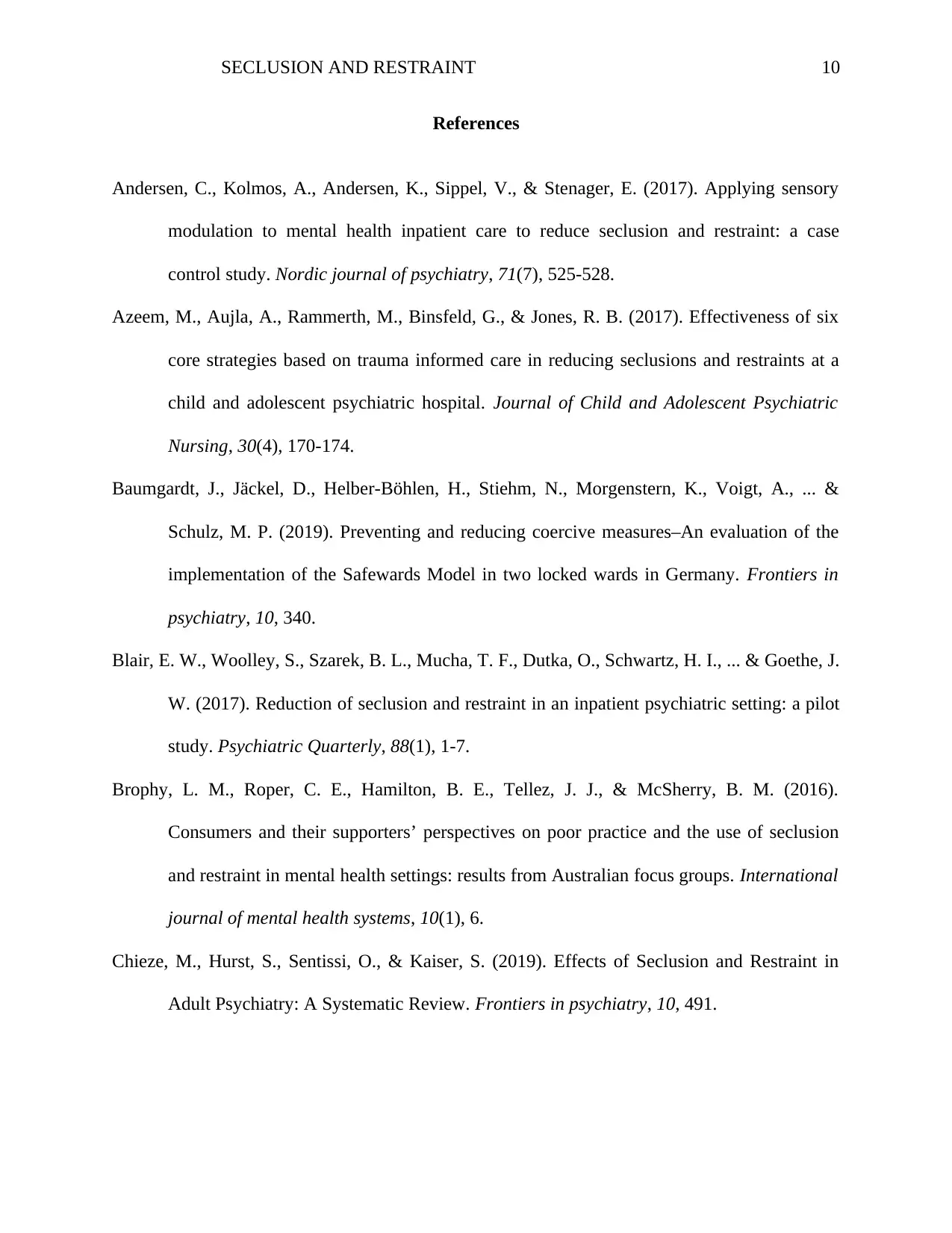
SECLUSION AND RESTRAINT 10
References
Andersen, C., Kolmos, A., Andersen, K., Sippel, V., & Stenager, E. (2017). Applying sensory
modulation to mental health inpatient care to reduce seclusion and restraint: a case
control study. Nordic journal of psychiatry, 71(7), 525-528.
Azeem, M., Aujla, A., Rammerth, M., Binsfeld, G., & Jones, R. B. (2017). Effectiveness of six
core strategies based on trauma informed care in reducing seclusions and restraints at a
child and adolescent psychiatric hospital. Journal of Child and Adolescent Psychiatric
Nursing, 30(4), 170-174.
Baumgardt, J., Jäckel, D., Helber-Böhlen, H., Stiehm, N., Morgenstern, K., Voigt, A., ... &
Schulz, M. P. (2019). Preventing and reducing coercive measures–An evaluation of the
implementation of the Safewards Model in two locked wards in Germany. Frontiers in
psychiatry, 10, 340.
Blair, E. W., Woolley, S., Szarek, B. L., Mucha, T. F., Dutka, O., Schwartz, H. I., ... & Goethe, J.
W. (2017). Reduction of seclusion and restraint in an inpatient psychiatric setting: a pilot
study. Psychiatric Quarterly, 88(1), 1-7.
Brophy, L. M., Roper, C. E., Hamilton, B. E., Tellez, J. J., & McSherry, B. M. (2016).
Consumers and their supporters’ perspectives on poor practice and the use of seclusion
and restraint in mental health settings: results from Australian focus groups. International
journal of mental health systems, 10(1), 6.
Chieze, M., Hurst, S., Sentissi, O., & Kaiser, S. (2019). Effects of Seclusion and Restraint in
Adult Psychiatry: A Systematic Review. Frontiers in psychiatry, 10, 491.
References
Andersen, C., Kolmos, A., Andersen, K., Sippel, V., & Stenager, E. (2017). Applying sensory
modulation to mental health inpatient care to reduce seclusion and restraint: a case
control study. Nordic journal of psychiatry, 71(7), 525-528.
Azeem, M., Aujla, A., Rammerth, M., Binsfeld, G., & Jones, R. B. (2017). Effectiveness of six
core strategies based on trauma informed care in reducing seclusions and restraints at a
child and adolescent psychiatric hospital. Journal of Child and Adolescent Psychiatric
Nursing, 30(4), 170-174.
Baumgardt, J., Jäckel, D., Helber-Böhlen, H., Stiehm, N., Morgenstern, K., Voigt, A., ... &
Schulz, M. P. (2019). Preventing and reducing coercive measures–An evaluation of the
implementation of the Safewards Model in two locked wards in Germany. Frontiers in
psychiatry, 10, 340.
Blair, E. W., Woolley, S., Szarek, B. L., Mucha, T. F., Dutka, O., Schwartz, H. I., ... & Goethe, J.
W. (2017). Reduction of seclusion and restraint in an inpatient psychiatric setting: a pilot
study. Psychiatric Quarterly, 88(1), 1-7.
Brophy, L. M., Roper, C. E., Hamilton, B. E., Tellez, J. J., & McSherry, B. M. (2016).
Consumers and their supporters’ perspectives on poor practice and the use of seclusion
and restraint in mental health settings: results from Australian focus groups. International
journal of mental health systems, 10(1), 6.
Chieze, M., Hurst, S., Sentissi, O., & Kaiser, S. (2019). Effects of Seclusion and Restraint in
Adult Psychiatry: A Systematic Review. Frontiers in psychiatry, 10, 491.
Paraphrase This Document
Need a fresh take? Get an instant paraphrase of this document with our AI Paraphraser
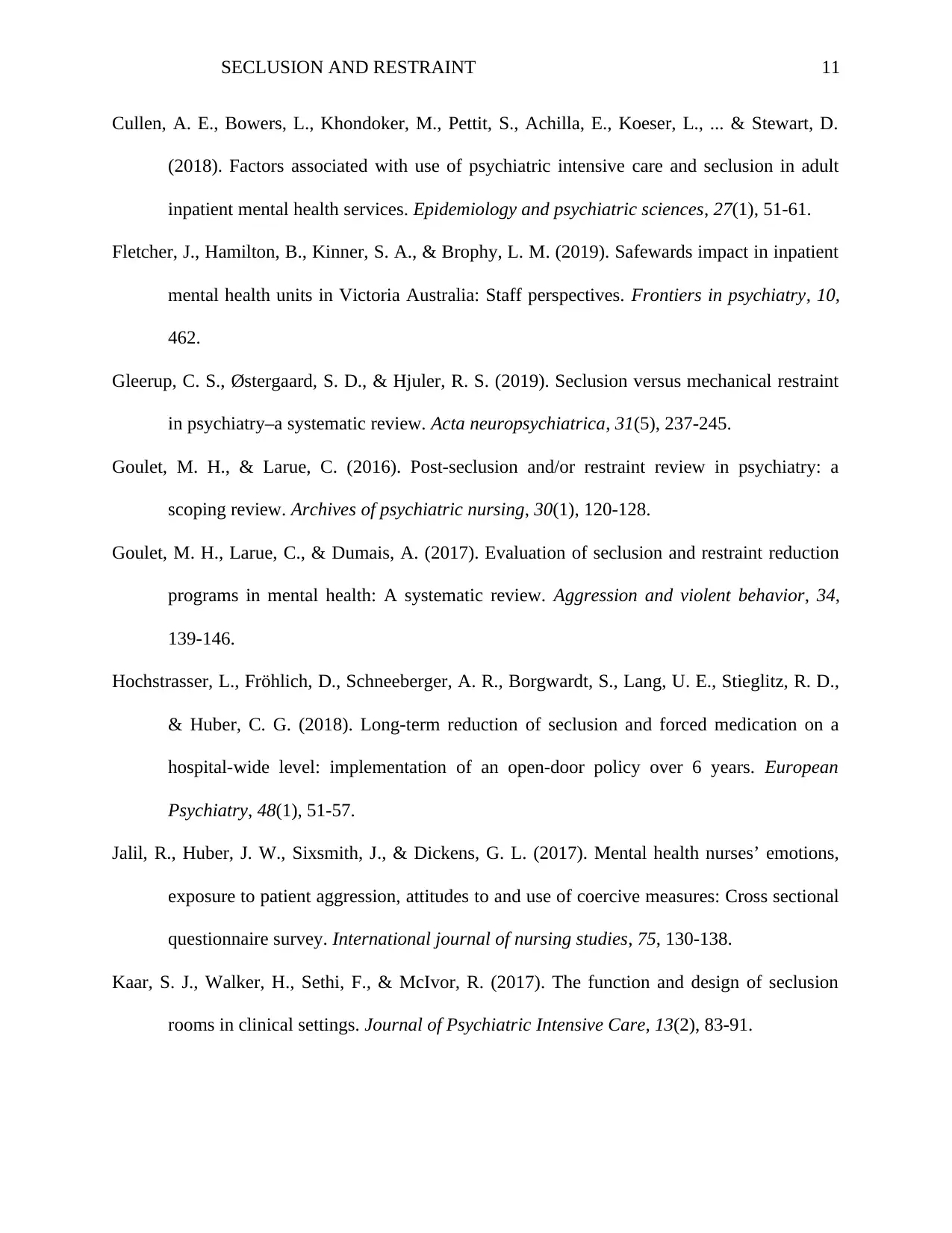
SECLUSION AND RESTRAINT 11
Cullen, A. E., Bowers, L., Khondoker, M., Pettit, S., Achilla, E., Koeser, L., ... & Stewart, D.
(2018). Factors associated with use of psychiatric intensive care and seclusion in adult
inpatient mental health services. Epidemiology and psychiatric sciences, 27(1), 51-61.
Fletcher, J., Hamilton, B., Kinner, S. A., & Brophy, L. M. (2019). Safewards impact in inpatient
mental health units in Victoria Australia: Staff perspectives. Frontiers in psychiatry, 10,
462.
Gleerup, C. S., Østergaard, S. D., & Hjuler, R. S. (2019). Seclusion versus mechanical restraint
in psychiatry–a systematic review. Acta neuropsychiatrica, 31(5), 237-245.
Goulet, M. H., & Larue, C. (2016). Post-seclusion and/or restraint review in psychiatry: a
scoping review. Archives of psychiatric nursing, 30(1), 120-128.
Goulet, M. H., Larue, C., & Dumais, A. (2017). Evaluation of seclusion and restraint reduction
programs in mental health: A systematic review. Aggression and violent behavior, 34,
139-146.
Hochstrasser, L., Fröhlich, D., Schneeberger, A. R., Borgwardt, S., Lang, U. E., Stieglitz, R. D.,
& Huber, C. G. (2018). Long-term reduction of seclusion and forced medication on a
hospital-wide level: implementation of an open-door policy over 6 years. European
Psychiatry, 48(1), 51-57.
Jalil, R., Huber, J. W., Sixsmith, J., & Dickens, G. L. (2017). Mental health nurses’ emotions,
exposure to patient aggression, attitudes to and use of coercive measures: Cross sectional
questionnaire survey. International journal of nursing studies, 75, 130-138.
Kaar, S. J., Walker, H., Sethi, F., & McIvor, R. (2017). The function and design of seclusion
rooms in clinical settings. Journal of Psychiatric Intensive Care, 13(2), 83-91.
Cullen, A. E., Bowers, L., Khondoker, M., Pettit, S., Achilla, E., Koeser, L., ... & Stewart, D.
(2018). Factors associated with use of psychiatric intensive care and seclusion in adult
inpatient mental health services. Epidemiology and psychiatric sciences, 27(1), 51-61.
Fletcher, J., Hamilton, B., Kinner, S. A., & Brophy, L. M. (2019). Safewards impact in inpatient
mental health units in Victoria Australia: Staff perspectives. Frontiers in psychiatry, 10,
462.
Gleerup, C. S., Østergaard, S. D., & Hjuler, R. S. (2019). Seclusion versus mechanical restraint
in psychiatry–a systematic review. Acta neuropsychiatrica, 31(5), 237-245.
Goulet, M. H., & Larue, C. (2016). Post-seclusion and/or restraint review in psychiatry: a
scoping review. Archives of psychiatric nursing, 30(1), 120-128.
Goulet, M. H., Larue, C., & Dumais, A. (2017). Evaluation of seclusion and restraint reduction
programs in mental health: A systematic review. Aggression and violent behavior, 34,
139-146.
Hochstrasser, L., Fröhlich, D., Schneeberger, A. R., Borgwardt, S., Lang, U. E., Stieglitz, R. D.,
& Huber, C. G. (2018). Long-term reduction of seclusion and forced medication on a
hospital-wide level: implementation of an open-door policy over 6 years. European
Psychiatry, 48(1), 51-57.
Jalil, R., Huber, J. W., Sixsmith, J., & Dickens, G. L. (2017). Mental health nurses’ emotions,
exposure to patient aggression, attitudes to and use of coercive measures: Cross sectional
questionnaire survey. International journal of nursing studies, 75, 130-138.
Kaar, S. J., Walker, H., Sethi, F., & McIvor, R. (2017). The function and design of seclusion
rooms in clinical settings. Journal of Psychiatric Intensive Care, 13(2), 83-91.
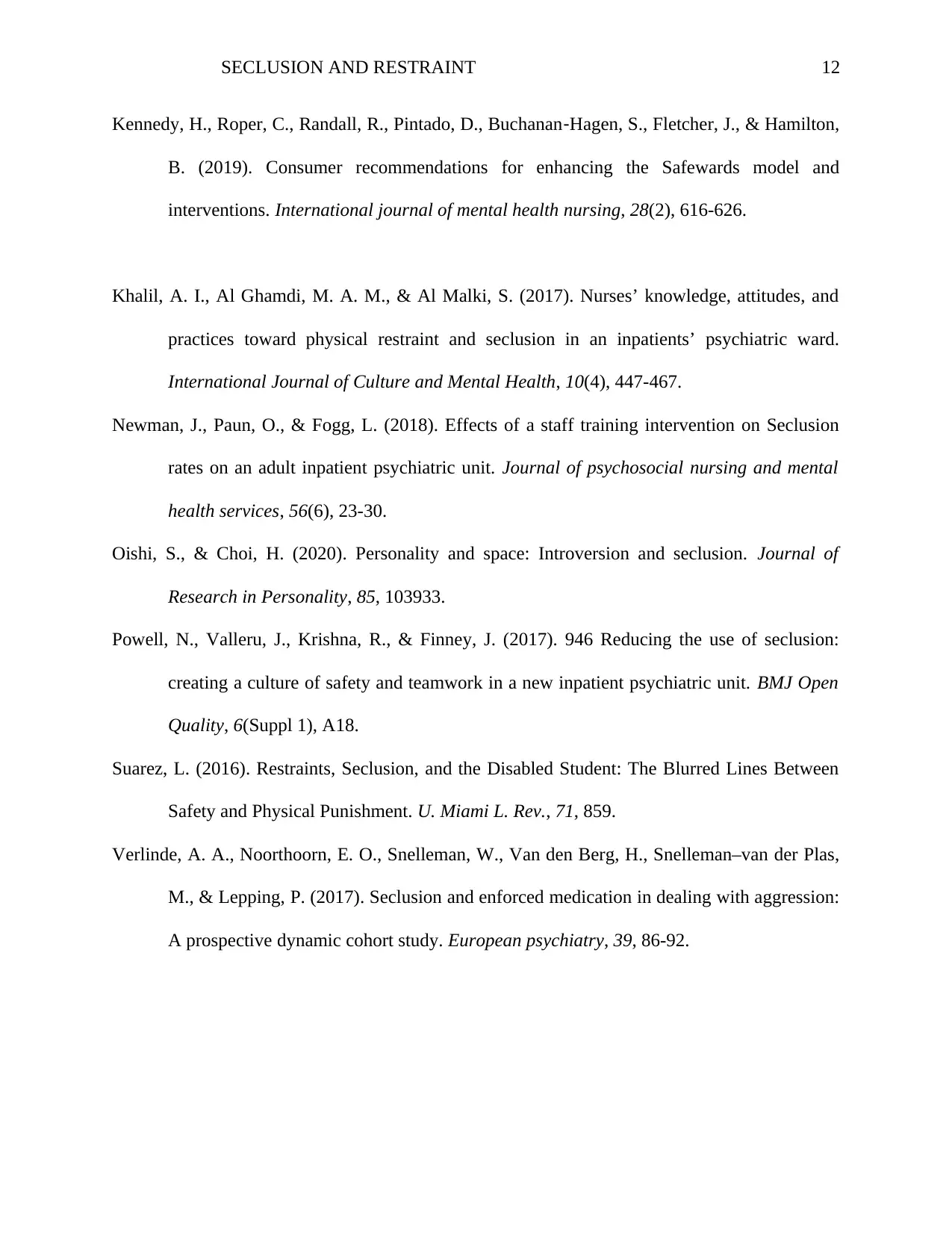
SECLUSION AND RESTRAINT 12
Kennedy, H., Roper, C., Randall, R., Pintado, D., Buchanan‐Hagen, S., Fletcher, J., & Hamilton,
B. (2019). Consumer recommendations for enhancing the Safewards model and
interventions. International journal of mental health nursing, 28(2), 616-626.
Khalil, A. I., Al Ghamdi, M. A. M., & Al Malki, S. (2017). Nurses’ knowledge, attitudes, and
practices toward physical restraint and seclusion in an inpatients’ psychiatric ward.
International Journal of Culture and Mental Health, 10(4), 447-467.
Newman, J., Paun, O., & Fogg, L. (2018). Effects of a staff training intervention on Seclusion
rates on an adult inpatient psychiatric unit. Journal of psychosocial nursing and mental
health services, 56(6), 23-30.
Oishi, S., & Choi, H. (2020). Personality and space: Introversion and seclusion. Journal of
Research in Personality, 85, 103933.
Powell, N., Valleru, J., Krishna, R., & Finney, J. (2017). 946 Reducing the use of seclusion:
creating a culture of safety and teamwork in a new inpatient psychiatric unit. BMJ Open
Quality, 6(Suppl 1), A18.
Suarez, L. (2016). Restraints, Seclusion, and the Disabled Student: The Blurred Lines Between
Safety and Physical Punishment. U. Miami L. Rev., 71, 859.
Verlinde, A. A., Noorthoorn, E. O., Snelleman, W., Van den Berg, H., Snelleman–van der Plas,
M., & Lepping, P. (2017). Seclusion and enforced medication in dealing with aggression:
A prospective dynamic cohort study. European psychiatry, 39, 86-92.
Kennedy, H., Roper, C., Randall, R., Pintado, D., Buchanan‐Hagen, S., Fletcher, J., & Hamilton,
B. (2019). Consumer recommendations for enhancing the Safewards model and
interventions. International journal of mental health nursing, 28(2), 616-626.
Khalil, A. I., Al Ghamdi, M. A. M., & Al Malki, S. (2017). Nurses’ knowledge, attitudes, and
practices toward physical restraint and seclusion in an inpatients’ psychiatric ward.
International Journal of Culture and Mental Health, 10(4), 447-467.
Newman, J., Paun, O., & Fogg, L. (2018). Effects of a staff training intervention on Seclusion
rates on an adult inpatient psychiatric unit. Journal of psychosocial nursing and mental
health services, 56(6), 23-30.
Oishi, S., & Choi, H. (2020). Personality and space: Introversion and seclusion. Journal of
Research in Personality, 85, 103933.
Powell, N., Valleru, J., Krishna, R., & Finney, J. (2017). 946 Reducing the use of seclusion:
creating a culture of safety and teamwork in a new inpatient psychiatric unit. BMJ Open
Quality, 6(Suppl 1), A18.
Suarez, L. (2016). Restraints, Seclusion, and the Disabled Student: The Blurred Lines Between
Safety and Physical Punishment. U. Miami L. Rev., 71, 859.
Verlinde, A. A., Noorthoorn, E. O., Snelleman, W., Van den Berg, H., Snelleman–van der Plas,
M., & Lepping, P. (2017). Seclusion and enforced medication in dealing with aggression:
A prospective dynamic cohort study. European psychiatry, 39, 86-92.
⊘ This is a preview!⊘
Do you want full access?
Subscribe today to unlock all pages.

Trusted by 1+ million students worldwide
1 out of 12
Related Documents
Your All-in-One AI-Powered Toolkit for Academic Success.
+13062052269
info@desklib.com
Available 24*7 on WhatsApp / Email
![[object Object]](/_next/static/media/star-bottom.7253800d.svg)
Unlock your academic potential
Copyright © 2020–2025 A2Z Services. All Rights Reserved. Developed and managed by ZUCOL.





